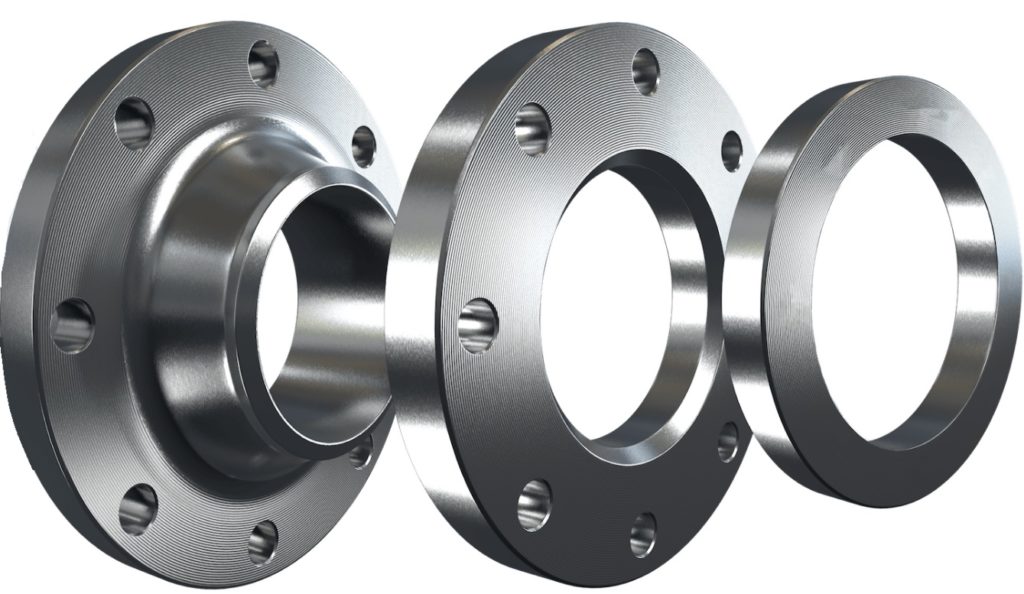Rating of the best flange manufacturers in Russia for 2022

The production of flanges is a long and complex process due to the technologies used and their features, so not every Russian steel plant is able to strictly adhere to the production methodology. Namely, compliance with production standards is considered the main indicator of the quality of this product. The standards also provide for some mandatory features of both the flanges themselves and the flange connections, which will affect their size and overall strength, and for this, the manufacturer must have a professional production line and a qualified staff.

Content
- 1 General information
- 2 Popular types of flanges produced in the Russian Federation
- 3 Features of Steel Flanges
- 4 Features of flanges for polyethylene pipes
- 5 Possible Disadvantages of the Manufacturing Process of Russian Flanges
- 6 Signs of a quality product
- 7 Rating of the best flange manufacturers in Russia for 2022
- 8 Conclusion
General information
The production of flanges and their connections in Russia is usually carried out not only by large factories, but also by small and medium-sized businesses focused on several types of production of pipeline parts at once. As a rule, their range consists of:
- The flanges themselves;
- Fasteners - washers, bolts, stud nuts;
- Gasket components - paronite, metal with an oval section, metal with an octagonal section, fluoroplastic.
The plants themselves can also differ from each other in the production methods used. In total, there are three most common types of release of the devices in question:
- Enterprises that use stamping and forging products;
- Enterprises using the casting method, including the electroslag centrifugal casting method, including vertical and horizontal casting;
- Enterprises engaged in the production of products using the rolled ring method.
A variety of release methods is due to the fact that a potential buyer has the opportunity to choose a product, starting from its needs. For example, if a buyer needs a product with a nominal bore of 300-350 millimeters, then he should pay attention to the products of a plant using the forging / stamping method. If you need a large diameter from 300 to 1800 millimeters, then it would be more rational to purchase goods from a factory specializing in centrifugal electroslag casting. And if there is a need for extra large samples (more than 1800 millimeters), then the best choice will be a product made in a factory that manufactures using the rolled rings method. Also, the question of using this or that method by an enterprise will directly depend on its economic capabilities, the ability to apply it on its own production lines, as well as the ability of the working staff to perform such work.
Separately, it is worth mentioning the issue of technical and information security of the production process, because the availability of basic permits and documentation for the release of any plant / factory is vital. In view of the fact that flange connections are objects of special responsibility, any of their units must be provided with appropriate accompanying documents, which indicate basic information about the degree of their quality and standardization. To fulfill this requirement, some firms can only get by with mandatory information (mandatory certification), but the best item is considered to be one that also has data on voluntary certification from its manufacturer in its “baggage”.
Popular types of flanges produced in the Russian Federation
The quality of these products will depend on the production methodology and the base raw materials. Most Russian enterprises prefer the forging and stamping mode, because it is the least expensive. Devices are stamped on presses with an impact force of 1.6 to 2.5 thousand tons. It is rare that a Russian enterprise can afford a press of greater capacity. As a result, based on the release methods used in this segment, only 4 flange classifications are widely used in the Russian Federation.
- Stamped.
For their manufacture, the impact mechanism of the press makes only one fall on the workpiece, and now the device is ready.
- Forged.
For them, sometimes there is not enough one-time power of the press, a single blow to the workpiece occurs with inadequate effort, so the shape is given by additional forging. The difference between the forging and stamping methods lies in the number of impacts that the raw material receives. And yet, stamping and forging can provide sufficient strength to the final product. At the same time, such production methods are not considered cheap, because the price of pressing equipment and its maintenance are considerable. Moreover, the method does not imply the possibility of using substandard raw materials, which means a minimum of production waste. As a result, the quality of the product is above average.
- Cast.
The production of such flanges is more concentrated in factories located in the Far East. This is due to the fact that the technology is widely used in China, and Russian firms purchase equipment for such production from a neighboring country at minimal cost.The technology itself involves pouring metal into prepared static molds, or casting can be carried out under pressure into rotating molds. However, objects produced by this method often (but not always) have a loose and porous metal structure and have reduced strength characteristics. Nevertheless, casting technology requires not too expensive equipment, and it is possible to save on raw materials, since it is easy to add various additives to the molten metal. As a result, the product can be marked as a derivative of steel of the 20th or 10th grade, but in fact be the 3rd. The “pluses” of this technology are considered to be absolute cheapness, and the “minuses” are the presence of pores and shells in the product, which reduces its strength. However, it is also possible to deal with such “minuses” - usually all the largest recesses on the parts are simply welded by welding directly during its installation.
IMPORTANT! According to the Russian regulatory framework established by GOST No. 33259 of 2015, only type 21 flanges can be produced by casting.
- Sliced.
They involve the passage of finishing machining by welding from a strip with a welded seam. The cut technology is typical for small or medium-sized companies specializing in the production of small batches of parts with a large diameter. The main "minus" is the savings on the process of mechanical finishing. Cutting from a solid sheet is practically the only way to get a product larger than DU-500 or any part of a non-standard shape. It is worth noting that in view of the fact that sheet material is used in production, which may have different thicknesses in different places, the walls of the future fixture may be different.Also, the quality of the final welding of the object will directly depend on the qualifications of the welder, and this is fraught with leaving unfinished holes.
Features of Steel Flanges
Steel samples on the Russian market are significantly ahead of all the rest in popularity - cast iron, plastic, and aluminum. Steel flanges have the following undoubted advantages:
- They are suitable for various types of pipes (not necessarily only steel, but also for polyethylene with a certain type of fastener);
- Able to withstand operating temperatures ranging from -70 to +450 degrees Celsius;
- Stainless steel is extremely resistant to aggressive chemical environments, including acids and alkalis;
- Considered completely environmentally friendly parts;
- They fully meet all the declared sanitary and bacteriological standards for the arrangement of special highways, for example, domestic water supply.
However, some "minus" is inherent in them. So, we can mention the price, which is somewhat superior to analogues made on the basis of aluminum or plastic. But a small overpayment quickly pays off, for example, in the case where the carbon steel of the flange will withstand only a year, its stainless steel counterpart can easily hold out for more than one decade.
Features of flanges for polyethylene pipes
The production of these models in the territory of the Russian Federation has been carried out for a long time. Such parts are flat disks designed for fastening valves and pipes, taps, and other fittings with bolts and studs. They are a fairly strong analogue of steel products, but are more recommended for polyethylene lines.Most Russian manufacturers specialize in the production of electrofusion couplings used to connect two HDPE pipes (with shaped components) to each other. Such a coupling has an open heating coil and does not require special tools for installation. Russian samples can easily withstand water pressure of 16 atmospheres and 10 atmospheres for gas. They are produced by low-pressure stamping, and are welded by simply heating the spiral with a welding machine. Also, HDPE tees, used to form branches in the mains for systems divided into the supply of technical and drinking water, are in good demand. With the help of HDPE flanges, it is possible to make a reliable and high-quality connection. For their fasteners, you do not have to use either studs or bolts, but only welding, which is optimal for this soft material. In principle, their popularity in the Russian territory is primarily due to their versatility, since they are easy to manufacture in any shape and fit almost any connection.
Possible Disadvantages of the Manufacturing Process of Russian Flanges
First of all, this situation takes place due to the dishonesty of some manufacturers. It is especially relevant for enterprises that have parallel production - and flanges, and fasteners, and gaskets. Often the following distribution scheme is revealed in the consumer market: the company buys up old and damaged parts, corrects their defects, renews them, paints them, and finally sells them as a new product, hiding behind the fact that it has its own production line for this. However, the fact of forgery is easy to recognize both visually and with the help of flaw detection equipment.In the first case, you can notice the peeling of the paint layer, and when using devices, the latter will show the uneven density of the material or the heterogeneity of the chemical composition of its raw materials. Also, the main sign of a low-quality product can be an extremely low price, which does not compare at all with a real and adequate one.
In addition, for a long time, manufacturers were guided by a whole series of GOSTs from 1980 (No. 12820, No. 12815, No. 12821), which regulated the design and manufacture of flanges. However, today all norms have already been brought into line with international standards and a single GOST No. 33259 of 2015 is in force for flanges. Nevertheless, some firms are still guided by the old regulatory framework in the production process and in the accompanying documents for the product, which is unacceptable. GOST 2015 not only combined the entire list of manufactured flange equipment, but at the same time canceled the old USSR GOSTs from the 80s. The purpose of the new document was to improve the quality of manufacturing standards for the products in question, to increase the durability and degree of wear resistance of the pipeline systems in which they are installed. The updated standard regulates more carefully and in detail the geometric characteristics, purpose, design features, production steps and forms of technical control for flanges of all types (from flat to collar), as well as prohibits the manufacture by casting of any considered products, with the exception of type 21.
Signs of a quality product
Based on consumer survey data, these include:
- Correct geometry - this flange ring is made in strict accordance with the requirements of the state standard and drawing sketches. Incorrect sample geometry may indicate the release of goods on an outdated line or according to "ancient" standards
- Uniform welding without breakout - this is ensured by the use of quality raw materials, which, when properly welded, will easily connect two pipes, although the steel of the pipe and the steel of the fixture may differ. The seam in any case will be uniform and even.
- Ease of connection - for a quality product, all the holes for bolts and studs match in full, they do not have to be further expanded. Parts of the product are completely suitable for the pipe of the corresponding diameter and their fastening is not difficult. The ease and strength of the connection is a mandatory subject of verification by the technical control of the enterprise before the release of a particular instance for sale.
Rating of the best flange manufacturers in Russia for 2022
Small business
3rd place: "Ventilation Plant ROTADO", Cheboksary"
The company was founded in 2015 through reorganization. It has been present in the considered segment of the market for more than 13 years. The staff is 50 people and is constantly expanding due to the increase in production. Only highly qualified specialists are involved in the work. All technological processes, from the processing of metal raw materials to the assembly of the final result, are carried out on our own line without the involvement of subcontractors. There is a full-time department of technical control, which significantly reduces the risk of the human factor in terms of the release of defects.

- Certification of products according to the international standard;
- Continuous increase in capacity;
- Completely own production.
- Small state.
2nd place: "TPK SPETSKREPEZH Omsk"
The company manufactures products using the knurling method using PROFIROLL rollers (Germany), which provides the rolled parts with increased mechanical and fatigue strength due to the hardening of their surface layer. Produces about a third of all products specified in GOST No. 33259 of 2015. An individual approach is applied to each client, it is allowed to fulfill orders according to the requirements of the old GOSTs of the 80s. Also, in the assortment there are various types of bends and gaskets, paronites, fittings, valves. Possible partial prepayment.

- Ability to work on individual orders;
- Expanded range;
- Partial prepayment.
- The limitation of the manufacturing method is only rolling.
1st place: LLC NPO Engineering Technologies, Omsk
The company specializes in the manufacture of steel, collar, flat, mating flanges, vessels, as well as devices, studs, nuts, bolts, gaskets, transitions, adapters, tees and rings "Armco". All production takes place strictly in accordance with regulatory documentation. It is possible to fulfill orders according to foreign standards ANSI, ASME, DIN, API. The range also includes thick-walled tees with non-standard geometry. It is allowed to manufacture products according to customer drawings.

- Focus on individual work with the customer;
- Ability to manufacture products according to foreign standards;
- Pretty wide assortment.
- Not detected.
Medium business
3rd place: OOO Trubarm, Moscow
This company operates on the market under its own trademark "LQH". More than a thousand tons of finished products (flanges of all types) are always present in its warehouse in Rostov-on-Don. The product is manufactured according to modern GOST and easily withstands the operating pressure of RU 10 and 16. There are also models with a diameter of less than 20 centimeters. All goods are certified, upon release they undergo strict quality / safety control. The company focuses on deliveries for the needs of the oil and gas, chemical and nuclear industries. The working process is controlled at all stages by highly qualified specialists of the enterprise - from the supply of raw materials to the transfer of products to the buyer.

- Constant availability of different product samples;
- Orientation to the industrial consumer;
- Full control of work procedures.
- Not detected.
2nd place: "Production enterprise ERDO LLC, Miass"
Products manufactured by this company undergo a process of additional hardening, which increases their strength. All models are designed according to current regulatory standards, although it is possible to manufacture parts according to customer drawings. In the production process, the latest foreign equipment is used, the final products undergo laboratory tests to test their functioning in conditions as close as possible to real ones. All goods correspond to the Russian nomenclature and are certified.

- Fifteen years of experience;
- Use of innovative foreign equipment;
- Possibility of production of products even in a single copy.
- Not detected.
1st place: OOO Spetspromrezerv, Nizhny Novgorod
The company manufactures and supplies various parts for pipe lines and valves for the needs of the chemical, gas, oil and nuclear industries. It is possible to produce parts with non-standard geometry. All types of flanges, bent bends, bottoms and plugs, supports and hangers, Armco rings, as well as fittings and elbows are always available.

- Orientation to the industrial consumer;
- Wide range of products;
- High quality.
- Not detected.
Large enterprises
3rd place: "LLC "Flange-plus", Cheboksary"
The company is focused on the production of products for enterprises of the housing and communal services system, as well as for large industrial facilities. The entire range of pipeline fittings and elements for it (tees, plugs, transitions, bends and flanges) is produced. There is a separate sector for the manufacture of fasteners - studs, bolts and nuts. A large assortment is always available, which allows you to make the highest quality and accurate choice of any desired device.

- A large assortment;
- Availability of auxiliary elements for sale;
- Orientation to the housing and communal services industry.
- Not detected.
2nd place: PromTechKomplekt LLC, Ufa
The company was founded in 1996 and is located in Ufa. Profile products are fasteners and elements for pipelines, mainly used in the oil and gas industry. The basic specialization is flanges (blind, welded, threaded), fasteners (nuts, bolts, studs, washers), coupling and nipple subs for pumping and compressor devices.Tees, ball valves, quick couplings, etc. are also on sale. All products are sold only in bulk. The company is constantly expanding its range, it is possible to manufacture products according to the customer's specifications.
- Extensive work experience;
- Work with technical specifications of the customer;
- Availability of related devices.
- Wholesale only.
1st place: Hardware and Flange Plant, Omsk
The plant is located in Omsk. It specializes in the production of fasteners and flanges, blanks for them, plugs and gaskets, tees and adapters. The plant's output capacities are capable of producing products weighing up to 3 tons with a diameter of 3 meters. In the course of production, an innovative technology of electroslag casting is used. Deliveries are possible to any region of Russia and neighboring countries. The production time for an individual order is no more than a month.

- Own logistics apparatus;
- Fast delivery times for individual orders;
- Ability to work with large dimensions of objects.
- Not detected.
Conclusion
Flanges are rightfully considered one of the most important reinforcement materials for fixing not only pipes, but also other parts, such as automotive components, railway beams, building structures, etc. All of their parts must be made from raw materials of good quality, and the production technology must meet all established standards. Currently, the vast majority of specialized Russian enterprises are quite successfully coping with this direction, their products meet the required standards.
new entries
Categories
Useful
Popular Articles
-

Top ranking of the best and cheapest scooters up to 50cc in 2022
Views: 131649 -

Rating of the best soundproofing materials for an apartment in 2022
Views: 127687 -

Rating of cheap analogues of expensive medicines for flu and colds for 2022
Views: 124516 -

The best men's sneakers in 2022
Views: 124030 -

The Best Complex Vitamins in 2022
Views: 121937 -

Top ranking of the best smartwatches 2022 - price-quality ratio
Views: 114978 -

The best paint for gray hair - top rating 2022
Views: 113393 -

Ranking of the best wood paints for interior work in 2022
Views: 110317 -

Rating of the best spinning reels in 2022
Views: 105326 -

Ranking of the best sex dolls for men for 2022
Views: 104362 -

Ranking of the best action cameras from China in 2022
Views: 102214 -

The most effective calcium preparations for adults and children in 2022
Views: 102010








